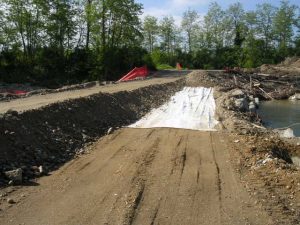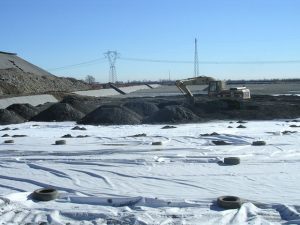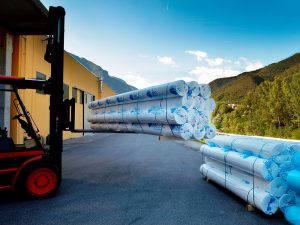Just like all materials for Civil Engineering, non woven geotextiles should be handled, stocked and transported with appropriate care in order to avoid alteration of characteristics required for each job. Hereunder some suggestions about handling, stocking, transportation and installation.
SITE PRELIMINARY WORKS
Soil must be duly prepared and sharp stones removed before laying the geotextile. During the laying the non-woven is subjected to different mechanical stress, according to the characteristics of soil, covering material and method used for laying down and compacting it. The mechanical characteristics of the non-woven have to be always selected in accordance to the specific conditions of installation.
OVERLAPPING
The overlapping is connected to different possible situations:
At least 30 cm when the soil is solid enough;
At least 50 cm when the soil can be easily deformed;
At least 50 cm for the protection of waterproofing sheets;
At least 1 m in case of underwater installation.
UV PROTECTION
GEO® is produced from synthetic fibres, consequently is subject to ageing due to long exposure under UV rays. .
COLD TEMPERATURE IS NOT A PROBLEM
Low temperatures do not affect the characteristics of geotextiles.
CARE ABOUT HIGH TEMPERATURES
High temperatures might affect the characteristics of geotextiles. Keep the supplier informed about how you intend to use the material, in order to get the suitable type.
For loading/unloading operations a frontal-loader with long stick or long shovels is necessary.
Stick or shovels should be at least 2/3 of the width of roll, in order to avoid damages to the carton/plastic core of roll.
In case above equipments cannot be used (it may happen on a site), ropes, chains and earth-moving machines may be used.
Rolls of GEO have a carton/plastic core inside and are externally protected by a foil of LDPE. Under these conditions the rolls can be stocked in open air space, without any relevant variation of the original characteristics. The ideal situation is however a covered stock area.
In case above indications cannot be followed, to protect rolls from contamination, UV rays, humidity etc, we suggest:
- To avoid direct contact between the soil and the rolls, especially when they are not used in a short time;
- To cover the rolls with a resistant and dull PE sheet;
- To ask supplier for having a suitable packing.


 Italiano
Italiano  English
English 


